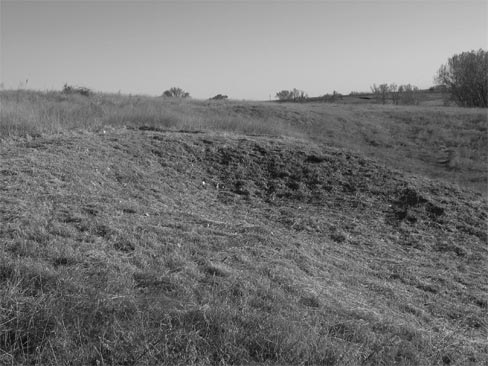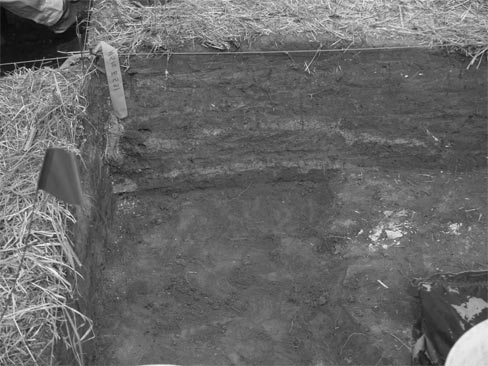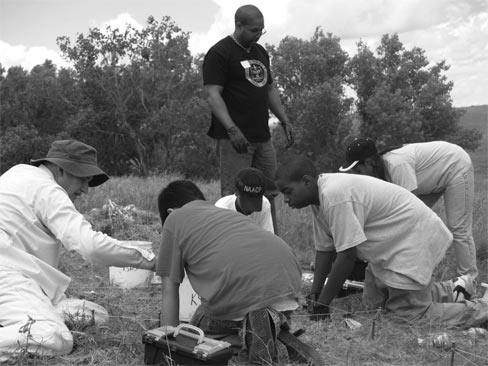Research Report
Excavation of an Early Dugout Homestead at Nicodemus, Kansas
by Sherda Williams
In the summer of 2007, more than 140 volunteers participated in the Kansas Archeology Training Program (KATP) field school at an 1877 dugout homestead near the historic community of Nicodemus, in northwest Kansas. Cosponsored by the Kansas Anthropological Association and the Kansas State Historical Society, the annual field school has been working in earnest to document the lives of the African American settlers who created the town of Nicodemus in the final year of Reconstruction after the American Civil War. Many of the Nicodemus pioneers established farms in the surrounding townships using the provisions of the Homestead and Townsite Pre-emption Acts.(1) The excavations will shed light on their lives and reveal the ways in which their experiences were comparable to other groups who helped settle the High Plains region of the United States.
Contemporary interest in the geography and cultural remains of Nicodemus dates back more than 20 years. In 1983, a Historic American Buildings Survey (HABS) team recorded the changes to the 160-acre platted town and mapped old dugouts and sod houses ("soddies")—a type of pioneer housing once prevalent across the Midwest.(2) The HABS team also conducted oral history interviews with local residents. The team prepared detailed site maps of a few of the properties, including the Johnson-Williams property.(3) Archeological research began in earnest in 2006 with a survey of sites where dugout or sod houses had been identified during the survey. One feature on the Johnson-Williams property was easily distinguished in the landscape—as the roof decayed on what turned out to be the dugout cellar, the structure collapsed into a bowl-shaped depression. The pedestrian survey led to a geophysical survey of the two most likely sites by National Park Service archeologists Steve De Vore and Jay Strudevant.(4) De Vore and Strudevant used magnetic, resistance, and ground-penetrating radar techniques at the Johnson-Williams sites. The magnetic survey technique proved especially useful in revealing concentrations of subsurface features at this site.(5)
 |
Figure 1. The bowl-shaped depression in the landscape indicates the location of the collapsed and filled former dugout cellar. (Courtesy of the National Park Service.) |
During the summer of 2006, Margaret Wood, a professor at Washburn University and one of two principal investigators at the site, and 10 of her students tested for intact remains at the Johnson-Williams property. Over a period of three weeks, the Washburn crew excavated several meter-wide test trenches to define the features and sample the strata in the house and root cellar dugout. In June 2007, KATP volunteers increased the number of test pits to define the size of the house site better. They also continued the deep exploration of the cellar and located other features of the homestead.
The past two years of exploration have provided valuable information about the homesteading experiences of Thomas and Zerena Johnson and their extended family. The Johnson family moved from Georgetown, Kentucky, to the Nicodemus area in September 1877 with more than 300 other African American settlers. The Johnson's adult daughter, Emma Williams, was eight months pregnant when she arrived, and she gave birth to a son, Henry—the first baby born in the new settlement. Thomas and Zerena Johnson (in their late 40s), Emma and her husband, Charles Williams, and other adult members of the extended family pooled their resources and established homesteads north of Nicodemus.(6) The Johnson's grandson, Henry, bought the homestead in 1906 after his marriage to Cora Ward in 1901. Most, if not all, of the six Williams children were "born and raised in a dugout and a sod house." The Williams family used the dugout home until the spring of 1920, when they moved into a newly constructed frame house on a hillside opposite the sod house.(7)
The Johnson homestead was located near a good spring and included a house partially dug into a slope. Although excavations of the site are not complete, it appears that the Johnsons built the house with a partial limestone foundation and at least some sod walls and a frame kitchen addition. They located a dugout cellar in the slope above the house. The KATP excavations also found what appears to be a midden. Archeologists and volunteers have been unable to confirm the location of a reported livestock shed or locate any privy sites.(8)
 |
Figure 2. The light and dark stripes of soil may delineate former sod blocks used to construct a wall of the house. (Courtesy of the National Park Service.) |
Artifacts recovered during the excavations and the personal recollections of Williams descendants have shed valuable light on the history and characteristics of the house and the cellar. The house measured approximately 40 by 33 feet in size. Juanita (Williams) Redd, a granddaughter of the Johnsons, remembered the dwelling as a "sod-and-dirt house….The west side was built on the back, that was sod…on the front part where the kitchen [addition] was, now that was framed. There were boards [on the roof], and then they put the sod on top of it to keep it from leaking…."(9) Redd described the house as having walls plastered with a solution made from crushed magnesia (limestone), a recollection corroborated by plaster found on the foundation wall of the house.(10)
The cellar measured approximately 19½ by 23 feet and was probably around 5 feet deep. It appears to have had shelving and bins built into the walls.(11) Wood's team found canning jar fragments, including one broken jar containing a cluster of peach pits, ceramic pieces, a door hinge, and frog bones. The next year, Flordeliz Bugarin (a principal investigator from Howard University in Washington, DC) and the KATP team found wood fragments of the cellar door, the base of a treadle sewing machine, more canning jar fragments, and skeletal remains of small animals. Bugarin will complete a full analysis of the 2007 findings and produce an excavation report next year. Both Wood and Bugarin have expressed interest in continuing the excavations in the future.
The Kansas Anthropological Association and the Kansas State Historical Society oversaw logistics, volunteer recruitment, and project management. The association also arranged a series of evening public lectures on archeology and history related topics. The field school organizers were particularly successful at engaging young people in the excavations—several teenagers and young adults were involved for the entire two weeks of the field school. Six members of a youth group from the Wichita Chapter of the National Association for the Advancement of Colored People spent a day assisting with the excavations, and two Howard University students participated with Bugarin. Quite a few local Nicodemus residents—most of whom are direct descendents of the Johnson and Williams families—visited the excavations both years.
The U.S. Secretary of the Interior designated the town of Nicodemus a National Historic Landmark in 1976. Twenty years later, Congress established Nicodemus National Historic Site.(12) The National Park Service partially funded the 2006 and 2007 excavations for the benefit of the interpretive programs at the park. Information from these excavations will help park staff develop interpretive media about the life of the first Nicodemus settlers.
The information gained from these excavations will provide a level of detail not always transmitted by the community's oral traditions nor by photographic and written records. Combined with the recollections of family members and more detailed historical research, the excavated sites will help convey the significance of Nicodemus to visitors and connect them with the site through stories that, as much as possible, will echo the true voices of these intrepid pioneers.(13)
About the Author
Sherda Williams is superintendent of Nicodemus National Historic Site in Nicodemus, Kansas.
Notes
1. The 1862 Homestead Act helped many people settle and ultimately own land in the American West. Before its repeal in 1976, about 270 million acres of land passed from federal to private ownership. Potential homesteaders, both men and women, had to be of age (21 years old) and a head of a household in order to stake a claim to a 160-acre parcel. Homesteaders registered their claims at the land office and paid a filing fee and small commission to the agent. The law stipulated that they had to live on the plot, build a house, make other improvements, and farm the remaining land. After five years, the homesteader gained legal title to the tract if they met the construction and agricultural requirements and neighbors could vouch for the improvements. An earlier urban counterpoint to the Homestead Act was the Townsite Preemption law of 1844 that provided for the private development of town lots prior to purchase. See Rita Napier, "Frontier Agricultural Settlements and Government Regulation: the Town Site Preemption Act of 1844," in Working the Range: Essays on the History of Western Land Management and the Environment, edited by J. R. Wunder (Westport, Connecticut: Greenwood Press, 1985), 113-27.
2. Everett L. Fly and La Barbara Wigfall Fly, "Ethnic Landscapes Come to Light," Landscape Architecture 77 (July-August 1987).
3. This mapping proved invaluable in pinpointing the locations of the dugout house and cellar. Historic American Buildings Survey, "Nicodemus, Kansas—A National Historic Landmark Black Settlement," HABS No. KS-49 (1983). The maps are available online at http://hdl.loc.gov/loc.pnp/hhh.ks0077, accessed on October 4, 2007.
4. National Park Service archeologist William Hunt was instrumental in developing these projects.
5. Steven L. De Vore, "Geophysical Investigations of Two Dugout Locations Associated with Nicodemus National Historic Site, Graham County, Kansas" (Lincoln, Nebraska: Midwest Archeological Center, National Park Service, 2007).
6. Margaret C. Wood, Dan Morrow, and Deborah Rumans, "Explorations of the Struggles and Promise of African American Settlement on the Great Plains: Archaeological Survey and Testing of Sites Related to the Settlement Period and Early History of Nicodemus, Kansas" (Nicodemus, KS: National Park Service, March 2007). The 1880 Census figures indicate the following probable family groups: Thomas and Zerena Johnson (50 and 48 years old respectively); Henry Johnson, wife Mary, and daughter Ella (24, 21, and 1 years); Ella Johnson (21 years); Charles Williams, wife Emma [Johnson] Williams, and adopted son Mack Schweitzer (32, 27, and 6 years); and Mary Johnson (possibly Thomas's sister-in-law), son Joseph Johnson, and granddaughters Lizzie and Clarinda Johnson (52, 27, 8, and 6 years).
7. Juanita [Redd] Williams, photocopy of hand written notes donated to Nicodemus National Historic Site by her niece, Yvonne Sayers, of Nicodemus, Kansas, August 2007. Woods notes that the original Johnson dugout may have been located elsewhere on the Johnson property and that Henry and Cora Williams built the house and cellar excavated by Washburn and KATP in 2006. Land record research indicates that Johnson owned the land until 1889, after which it changed hands several times. Henry and Cora Williams bought the land in 1906. Analysis of the cultural material from the first (2006) excavation of the domestic structure set an abandonment date after 1907, perhaps as late as 1915 (Wood, Morrow, and Rumans, 2007, Chapter 3).
8. Flordeliz T. Bugarin, "In the Midst of Wildflowers: KATP Searches for the Nicodemus Past," Kansas Preservation 20 no. 4 (2007): 7-13.
9. Fly and Fly, 38.
10. Wood, Morrow, and Rumans, 2007, 121.
11. Ibid, 101.
12. The historic site includes five properties in the town of Nicodemus.
13. More information on the 2006 Washburn University excavations at the Johnson-Williams homestead is available on the Nicodemus National Historic Site website at http://www.nps.gov/nico/parknews/index.htm, accessed on October 4, 2007. Articles relating to the 2007 KATP excavations are available on the Kansas State Historical Society website at http://www.kshs.org/resource/ks_preservation/kpjulaug07.pdf and the NPS Archeology Program website at http://www.nps.gov/archeology/sites/npSites/nicodemus.htm, accessed on October 4, 2007.

